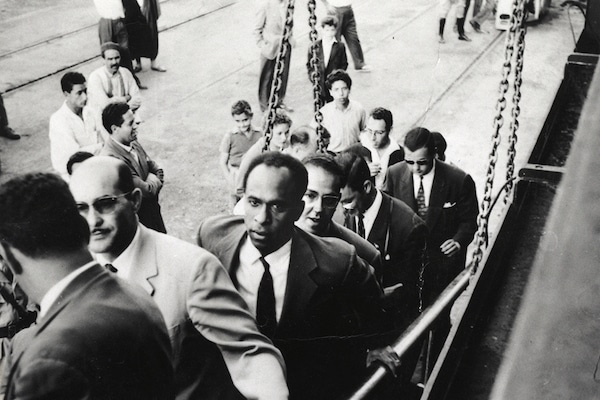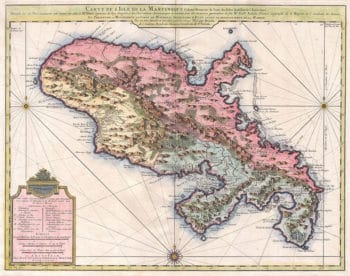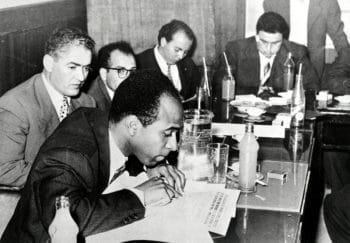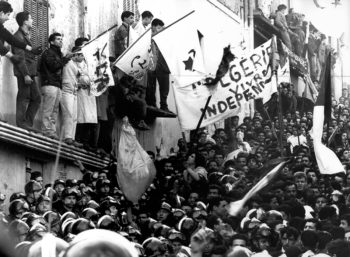French colonial map of Martinique from the Covens & Mortier’s Atlas Nouveau, 1942.
Wikimedia Commons / Geographicus Rare Antique MapsOn this earth there is that which deserves life.
– Mahmoud Darwish
Frantz Fanon was born on the Caribbean island of Martinique on 25 July 1925. He died in the United States, from leukaemia, on 6 December 1961. He was thirty-six years old. At thirty-six he had been a protagonist in two wars, a political militant in the Caribbean, Europe and North Africa, a playwright, a practicing psychiatrist, the author of numerous articles in scientific journals, a teacher, a diplomat, a journalist, the editor of an anti-colonial newspaper, the author of three books, and a major Pan-Africanist and internationalist.
Like Ernesto “Che” Guevara–another revolutionary who valued the poetic and was a committed internationalist, doctor, soldier, teacher, and theorist–Fanon’s life was marked by a permanent, courageous, and militant motion into the present, and into the specificity of the situations in which he found himself.
Fanon’s thought carries, in Ato Sekyi-Otu’s memorable phrase, an ‘irrepressible … openness to the universal’. In the realm of the political, as in the poetic, the truest route into the universal has always been through an intense engagement with the particular in its concrete manifestations in space and time: this piece of land occupied in the interstices of this city, these women rebuilding in the ruins of the last attack, the plastic burning in this brazier as the night wears on, these men stepping out of the shadows with these guns.
‘Courage’, Alain Badiou writes, ‘is a local virtue. It takes up a morality of the place’. This is the terrain on which the radical thinkers who produce work that sustains a capacity for illumination and inspiration across space and time ground their intellect. It can be dangerous terrain. For the militant the price for the possibility that, in Fanon’s words written in France in 1952, ‘two or three truths may cast their eternal brilliance over the world’ may be that ‘the possibility of annihilation’ is risked.
For the radical intellectual, the confrontation with the particular may sometimes require solitary labour, as in some forms of prison writing. But the primary ground of militant reason is, in Karl Marx’s words, ‘participation in politics, and therefore real struggles’. And emancipation–communism, in Marx’s words–is ‘the real movement which abolishes the present state of things’ and not ‘an ideal to which reality [will] have to adjust itself’.
For Marx, the world will only be shaped by the most valuable insights of philosophical striving when philosophy itself becomes worldly via participation in struggle. Cedric Robinson speaks to this imperative when he writes that, in order to ‘cement pain to purpose, experience to expectation, consciousness to collective action’, it is necessary to ensure that ‘the practice of theory is informed by struggle’.
For Fanon, the development of radical reason–which is to say emancipatory reason – certainly includes conversation with philosophy as it is defined by Paulin Hountondji: ‘not a system but a history’. But, the plane of becoming on which this work constitutes itself is, not unlike Antonio Gramsci’s philosophy of praxis, that of struggle–the struggles of the damned of the earth. Fanon is, in Gramsci’s terms, a democratic philosopher. ‘This philosopher’, Peter Thomas writes, ‘is no longer defined in terms of separation from the “life of the people”, but as an expressive element of that life which it aims to cultivate, increasing its capacity for active relations of knowledge and practice’.
Since his death in late 1961, Fanon’s thought has had an extraordinary life, reaching from the maelstrom of the Algerian revolution to the American prison, the French banlieue, the Brazilian favela, and far beyond. Sometimes expressed via a potent poeticism and always rooted in a radical humanism–an immediate, universal and militant affirmation of the equality and value of human life–his political vision is resolutely opposed to the Manichean logic of colonialism.
Manichaeism is a central concept in Fanon’s thought. The term comes to us from a religion founded by Mani, known by his followers as the ‘Apostle of Light’, in Babylonia in the third century. Mani wove a set of diverse religions into a single new faith that proposed an absolute dualism between good and evil represented, in symbolic terms, by light and dark. Brought into contemporary discourse as metaphor, Manichaeism speaks to an absolute split between all things light and good (and true, beautiful, clean, healthy, prosperous, etc.) and all things dark and evil (and false, ugly, dirty, diseased, impoverished etc.). It is an inherently paranoid orientation to the world.
Fanon’s thought is marked by an axiomatic commitment to an immediate and radical egalitarianism–including the recognition of a universal capacity for reason. It is shaped, in its deep structure, by a profoundly dialectical sense of the capacity for the human to be in motion. His thought, taken as a whole, did not waver from what Aimé Césaire, the extraordinary surrealist poet, described as the obligation ‘to see clearly, to think clearly—that is, dangerously’.
Liberation must, Fanon insists, restore ‘dignity to all citizens, fill their minds and feast their eyes with human things and create a prospect that is human because conscious and sovereign persons dwell therein’. For Fanon, the restoration of dignity is not a matter of return. The journey towards what, in the last year of his life, in a letter written to the Iranian intellectual Ali Shariati, he called ‘that destination where humanity lives well’ is undertaken via a constant process of becoming and enlargement of the sphere of democratic reason. As Lewis Gordon notes, for Fanon, legitimacy is not a matter of offering proof of racial or cultural authenticity; rather, it emerges ‘from active engagement in struggles for social transformation and building institutions and ideas that nourish and liberate the formerly colonized’.
For the university-trained intellectual, Fanon poses a simple demand, but one that retains its radical charge almost sixty years later: to move beyond the ontological and spatial ordering of oppression and commit to a form of insurgent and democratic praxis in which ‘a mutual current of enlightenment and enrichment’ is developed between protagonists from different social locations.
(Mis)readings
Fanon’s last book, Les Damnés de la Terre, arrived in the world shortly after he left it. In 1963 it was mistranslated into English as The Wretched of the Earth. Some scholars prefer to refer to it as The Damned of the Earth, which is a better translation. From the outset, Jean-Paul Sartre, a committed anti-colonial intellectual, set many readers off course with an introduction that–although sympathetic–misinterpreted Fanon as a Manichean thinker. In 1970 Hannah Arendt, a thinker who acquired significant standing in the North American academy and beyond despite taking consistently anti-black positions, compounded the problem with an influential misreading that reduced Fanon’s complex thought to his support for armed struggle against colonialism.
However, there is a set of intellectuals who have read Fanon as a sophisticated thinker rather than a racial archetype. Paulo Freire was one of the first major intellectuals to understand Fanon’s theory of praxis. In 1968, Freire was finishing the manuscript of his second book, Pedagogy of the Oppressed, in Santiago while living in exile from the military dictatorship in Brazil. In an interview in California in 1987, he recalled: ‘A young man who was in Santiago on a political task gave me the book The Wretched of the Earth. I was writing Pedagogy of the Oppressed, and the book was almost finished when I read Fanon. I had to rewrite the book’.
After reading Fanon, Freire developed a radical humanism committed to the immediate recognition of the full and equal personhood of the oppressed as a pre-condition for emancipatory action. Like Fanon, his form of praxis is predicated on an ethic of mutuality between the authorised intellectual and people who have not had access to much formal education.
Pedagogy of the Oppressed was published later that year and, in 1972, it was taken up by the South African Students’ Organisation (SASO) which had been formed by Steve Biko, Barney Pityana, Rubin Phillip, and others, in 1968. Beginning in Durban, Freirean ideas became central to a form of radically democratic action that aimed to work towards critical consciousness as a shared project, rather than to announce new versions of what Marx had called ‘dogmatic abstraction’ to the people.
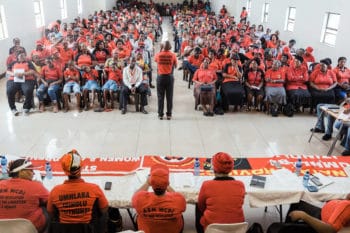
Meeting of Abahlali baseMjondolo, South Africa’s shack dwellers’ movement, in February 2020. Rajesh Jantilal
In the late 1970s, and through the 1980s, Freirean ideas about praxis–shaped to a significant extent by Fanon, and in many cases read together with Fanon–were central to the political work undertaken in workplace and community struggles across South Africa. Freire’s theory of praxis enabled the emergence of some of the most impressive and powerful social forces on the planet at the time, in which ordinary people became central protagonists in struggle, and in the making of meaning, counter-power, and history from below.
In terms of reading Fanon as a theorist of praxis, the quick but extraordinary and enduring response to the 1992 Los Angeles riots by Sylvia Wynter was exemplary. In her explicitly Fanonian conclusion to No Humans Involved: A Letter to My Colleagues, she reached beyond Los Angeles and towards ‘the throwaway lives . . . of the vast majority of peoples who inhabit the “favela/shanty town” of the globe and their jobless archipelagos’. Wynter argued that, for university-trained intellectuals–who she understands as trained ‘grammarians’ of the constituted order, an order that does not count everyone as equally human–it is imperative to ‘marry our thought’ to that of the oppressed.
In 1996, Sekyi-Otu produced a brilliant and deeply dialectical African-centred reading of Fanon that situated the question of praxis, and–crucially–what Sekyi-Otu calls ‘the reprieve of prodigal reason’ at the heart of what Fanon referred to as ‘the weary road to rational knowledge’. Scholars like Nigel Gibson, Lewis Gordon and Tracy Sharpley-Whiting have also significantly enriched the scholarship on Fanon.
Radical Humanism
In contemporary South Africa, Fanon is read and discussed from the political education workshop organised on a hard-won urban land occupation to the trade union political school to the academy, in both its dissident spaces and in its highest reaches. Fanon’s life and work offer inspiration as well as analytical acuity to all of these audiences. Achille Mbembe, writing from Johannesburg, explains that:
I myself have been attracted to Fanon’s name and voice because both have the brightness of metal. His is a metamorphic thought, animated by an indestructible will to live. What gives this metallic thinking its force and power is the air of indestructibility and, its corollary, the injunction to stand up. It is the inexhaustible silo of humanity that it houses and which, yesterday, gave the colonised strength and which, today, allows us to look forward to the future.
There are numerous lines of connection that open fruitful possibilities for dialogue between Fanon’s work and contemporary forms of struggle. These range from his account of the centrality of the racialisation of space and the spacialisation of race in the settler colonial project, to questions of language, policing, the racial unconscious, and–of course–the brutal realities of what has come to be termed the postcolony.
In the metropolitan academy, Fanon’s humanism is, with notable exceptions–such as the valuable work of Paul Gilroy – often ignored or treated as passé, or even pre-critical. Sneering condescension from people whose humanity has never been placed in question is not uncommon. But in contemporary South Africa, it is the question of the human–of how the count of the human is made, and how humanity is asserted–that ties Fanon’s theoretical work most closely to the intellectual work undertaken in the often-perilous struggles for land and dignity. Here, dignity is understood as the recognition of full and equal humanity, including the right to participate in deciding public affairs. These kinds of struggles–frequently undertaken against considerable violence from the state and the ruling party, and the contempt of civil society–are fundamentally rooted in an insurgent humanism which legitimates and sustains resistance. Nigel Gibson’s important work on Fanon and South Africa has a firm grasp of this.
The contemporary political potency of radical humanism is not unique to South Africa. From Caracas to La Paz to Port-au-Prince, accounts of popular and potentially emancipatory politics frequently stress the neighbourhood as an important site of struggle, the road blockade and the occupation as important tactics, and the affirmation of the humanity of the oppressed as the foundation of the strength to sustain resistance. This affirmation is often explained as being sustained by social practices in which women play a leading role, and frequently spoken of in terms of the recovery of dignity. It is not uncommon to hear people speak of indignity as consequent to the expropriation of the right to participate in making decisions about public affairs, as well as land, labour, and bodily autonomy.
The question of the human is, in part, a question of how oppression seeks to distribute the attribution of the capacity for reason, and to recognise some speech as speech while dismissing other speech as mere noise–noise consequent to unreason. It is a question of how we determine who is honoured and who is dishonoured, who can be slandered with impunity and who deserves public respect, whose life is valued and whose is not, whose lives should ordinarily be governed with law and whose should routinely be governed with violence, and who, in death, should be mourned and who should not. The denial of full and equal humanity allows oppression to draw the line between forms of organisation and contestation that it can see as politics, and those that it cannot, and between civil society and the sphere of engagement that it considers to be mindless, criminal, or a manifestation of conspiracy.
Fanon’s radical humanism, a humanism made–in Césaire’s famous phrase–‘to the measure of the world’, sustains a capacity to speak with real power to many of the ways in which the question of the human is posed, and contested, from within contemporary forms of grassroots militancy undertaken from zones of social exclusion and domination.
The Open Door of Every Consciousness
Before coming to France in late 1946 to study medicine, and then to specialise in psychiatry, Fanon had been a soldier with the Forces françaises libres (‘the Free French Forces’), fighting against fascism in Europe while simultaneously confronting constant racism within the French army. In 1944 he was wounded in the battle for Colmar, a French town near the German border, and received the Croix de Guerre for bravery. In 1945 he returned home to Martinique, where he worked for the successful campaign by Césaire to be elected as the mayor of Fort de France on a Communist platform.
From the outset, Fanon’s writings in France were concerned with how racism produces what Michel-Rolph Trouillot would later term ‘an ontology, an implicit organization of the world and its inhabitants’. In The North African Syndrome, an essay published at the age of 26, Fanon examined how French medical science approached the North African migrant with ‘an a priori attitude’ that, crucially, is not derived ‘experimentally’ but, rather, ‘on the basis of an oral tradition’. He observed that that ‘The North African does not come with a substratum common to his race, but on a foundation built by the European. In other words, the North African, spontaneously, by the very fact of appearing on the scene, enters into a pre-existing framework’. In this framework, the North African appears to the French doctor as ‘a simulator, a liar, a malingerer, a sluggard, a thief’.
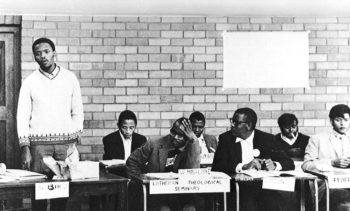
Stephen Biko (standing) at the 1971 conference of the South African Students’ Organisation (SASO). The Alan Taylor Residence hall, where the event was held, was the University of Natal’s black-only residence for medical students under apartheid.
Steve Biko Foundation
Fanon shows that in the consciousness of the racist, and in the general intellect of racist social formations, the imagined ontological split on which racist ideology depends is part of what Immanuel Kant called the a priori–the categories through which sense is made of experience. This deception of reason–what Gordon calls ‘racist rationality’–results in racist societies producing forms of knowledge that, while authorised as the most fully formed instances of reason at work, are fundamentally irrational.
Fanon’s first book, Peau noire, masques blancs was published in the French summer of 1952, a few months after The North African Syndrome, and in the same year as Richard Wright’s Invisible Man, with which it has often been read. It was translated into English as Black Skin, White Masks in 1967. Superbly analysed by Gordon, it is both a statement of a radical and affirmative commitment to human freedom and a brilliant critique of racism in the Caribbean and in the metropole that engages questions ranging from language to popular culture, to romance and sex, to anthropology and psychology. It remains a foundational text for critical race studies.
Black Skin, White Masks was dictated to Josie Dublé, a comrade and lover who Fanon would later marry, as he paced up and down in his student room in Lyon. The prose carries a sense of the cadence of that motion and is sculpted by a compelling poeticism with discernible influences from his reading of poets like Aimé Césaire and Jacques Roumain. Parts of the book read, not unlike some passages from Walt Whitman, as if they were meant to be declaimed.
Every politics rests, consciously or not, on an ontology, on a theory of human being. For Fanon, there are two signal facts about human being, both mediated through an affirmative disposition. The first is that the human being ‘is motion toward the world’. In the tradition of French philosophy that runs from Sartre to Badiou, the prospect of what Fanon called the ‘mutation’ of consciousness–the capacity of the human being to change–would remain a central theme of his thought until the end. In his work produced during his immersion in the Algerian revolution, the mutation of consciousness would be explored in the context of collective struggle.
For Fanon, consciousness is not only dynamic. The second signal fact about human being is that consciousness is free in the way that it is in Sartre’s existentialism. For Fanon, ‘In the world through which I travel, I am endlessly creating myself. I am a part of Being to the degree that I go beyond it’. But Fanon does not share the pessimism of Sartre’s view that the human is ‘a useless passion’. Fanon’s humanism carries a fundamental optimism that can arguably be located in a tradition of Caribbean humanism with African antecedents and parallels that runs from Toussaint Louverture through to Aimé Césaire and on to Sylvia Wynter and Jean-Bertrand Aristide. He begins and ends his first book by insisting that ‘Man is a yes’.

Meeting of the United Democratic Front (UDF), a leading anti-apartheid body that launched in 1983 and joined the struggles of many South African organisations.
Wits Historical Papers
His humanism also carries a universal dimension: ‘Anti-Semitism hits me head-on: I am enraged, I am bled white by an appalling battle, I am deprived of the possibility of being a man’. Fanon affirms that ‘Every time a man has contributed to the victory of the dignity of the spirit, every time a man has said no to an attempt to subjugate his fellows, I have felt solidarity with his act’. Of course, the use of gendered language that is sometimes (but not always) introduced in translation, is unfortunate for an intellectual who insisted that ‘[We] must guard against the danger of perpetuating the feudal tradition which holds sacred the superiority of the masculine element over the feminine’.
For Fanon, the imperative to recognise every consciousness as autonomous and possessed of the capacity to reason and to exercise freedom is ethical as well as empirical. He concludes his first book, Black Skin, White Masks, by insisting that ‘At the conclusion of this study, I want the world to recognize, with me, the open door of every consciousness’. Fanon’s commitment to the recognition of every consciousness as an open door is a universal principle, a militant axiom, entirely opposed to the aristocratic conception of philosophy that, running from Plato to Nietzsche, and on to their contemporary descendants, reserves reason for a privileged caste. Earlier in the book, he writes as a clinician and in intimation of the theory of praxis that would later be worked out in the vortex of the Algerian war:
Examining this 73-year-old farm woman, whose mind was never strong and who is now far gone in dementia, I am suddenly aware of the collapse of the antennae with which I touch and through which I am touched. The fact that I adopt a language suitable to dementia, to feeblemindedness; the fact that I ‘talk down’ to this poor woman of 73; the fact that I condescend to her in my quest for a diagnosis, are the stigmata of a dereliction in my relations with other people.
Manichean Delirium
Black Skin, White Masks is also a theory of how racism ‘encases’ human being. Fanon describes wanting ‘to come lithe and young into a world that was ours and to help to build it together’ but finds himself ‘sealed into a crushing objecthood’. He offers a theory of racist ideology as a form of ‘Manichean delirium’ in which, in the racist imagination that structures everything from advertising to entertainment, science, and the unconscious, whiteness is associated with beauty, reason, virtue, cleanliness, and so on, and blackness with the obverse. To the limited extent that progress is possible within the logic of this schema, ‘From black to white is the course of mutation. One is white as one is rich, as one is beautiful, as one is intelligent’.
Fanon describes the inevitable failure of attempts to find a way to win the recognition required to live freely against the crushing weight of racism: ‘Every hand was a losing hand for me’. One of those losing hands was reason. The fanaticism with which reason was coded as white in the racist imagination was such that it was impossible to be recognised as simultaneously reasonable and black: ‘[W]hen I was present, it was not; when it was there, I was no longer’. The end result is collapse: ‘Yesterday, awakening to the world, I saw the sky turn upon itself utterly and wholly. I wanted to rise, but the disembowelled silence fell back upon me, its wings paralyzed. Without responsibility, straddling Nothingness and infinity, I began to weep’.
Fanon concludes that there can be no personal solution to the problem of racism. What is required is ‘a restructuring of the world’. He ends Black Skin, White Masks by asserting that ‘To educate man to be actional, preserving in all his relations his respect for the basic values that constitute a human world, is the prime task of him who, having taken thought, prepares to act’. This is a commitment to praxis, a term that appears consistently in the original French publications of the work that he would go on to produce in Tunis, but which is largely elided in English translations.
Radical Mutations
After concluding his studies in France, Fanon took up a position as the head of the Blida-Joinville Psychiatric Hospital in Algeria, a colonial institution in which he implemented radical reforms. Alice Cherki, an intern at the hospital, and later Fanon’s most sensitive biographer, recalls that his aim as a clinician was ‘not to muzzle madness but to listen to it’.
In 1956, describing colonial society as ‘a web of lies, of cowardice, of contempt for man’, he resigned from his position at the hospital to join the revolution against French colonialism from a base in Tunis. He would work for the revolution as a psychiatrist, journalist, editor, and diplomat, undertake reconnaissance work, and teach philosophy–including Jean-Paul Sartre’s Critique de la raison dialectique (Critique of Dialectical Reason)–to soldiers on the front. In his years as a revolutionary he would encounter people like Simone de Beauvoir, Cheikh Anta Diop, Patrice Lumumba, Es’kia Mphahlele, Kwame Nkrumah, and Jean-Paul Sartre.
In December 1957, Abane Ramdane, Fanon’s closest comrade in the Algerian national liberation movement, was assassinated by a right-wing faction within the movement that aimed to subordinate political work to military authority. Fanon’s name was placed on a list of people to be watched, and subject to a similar fate should there be open defiance within the movement in response to the assassination. From this point on, Fanon lived knowing that there was a potential of significant risk from the authoritarian nationalists in the movement, and a vital struggle within the struggle.
Fanon’s second book, L’An V de la Révolution Algérienne, was published in 1959 and translated into English in 1965. In English it has been known as A Dying Colonialism since 1967. The book is, Fanon explains, an account of how participation in the struggle ‘to impose reason on … [colonial] unreason’, to oppose ‘the indignity, kept alive and nourished every morning’, results in what he calls ‘essential mutations in the consciousness of the colonized’.
It is, as Cherki observes, very deliberately a book about ‘the common men and women’–women and men in a society in motion, rather than the personalities and actions of revolutionary elites. In contrast to elitist forms of anti-colonialism that aim to direct ‘the masses’ from above, the imperative to recognise the ‘open door of every consciousness’ is extended to the common people.
Fanon makes his position clear at the outset: ‘The power of the Algerian Revolution . . . resides in the radical mutation that the Algerian has undergone’. In the context of revolutionary struggle, mutation has escaped the stranglehold of racist ideology–which can only understand progress as movement from black to white–and is now an autonomous and self-directed process.
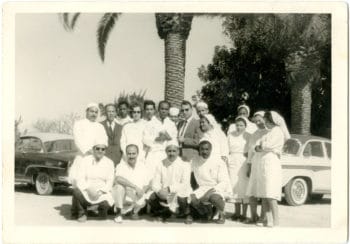
Frantz Fanon and his medical team at the Blida-Joinville Psychiatric Hospital in Algeria, where he worked from 1953 to 1956.
Frantz Fanon Archives / IMEC
The book offers five case studies of the kind of ‘radical mutation’–or change in consciousness–that can take place in the vortex of struggle, of collective motion. In each case, Fanon offers an account of how the Manichaeism introduced by colonialism breaks down in struggle. The book examines how technologies introduced through colonialism and initially identified as inherently colonial–namely the radio and biomedical medicine–are taken up in struggle, how gender relations change in struggle, and, in the final chapter, how some of the European minority choose to offer support to the anti-colonial revolution.
Perhaps unsurprising given the all-or-nothing context of the Algerian war, Fanon’s case studies of the development of radical political solidarities across class, gender, and race all plot a unidirectional movement of progressive enlightenment. For instance, the doctor –formerly seen as an agent of colonialism, but now ‘Sleeping on the ground with the men and women of the mechtas, living the drama of the people’–becomes ‘our Doctor’.
Gendered norms are also shown to change in struggle. Fanon describes the Algerian woman, ‘who assumed an increasingly important place in revolutionary action’, as ‘bursting the bounds of the narrow world in which she had lived … [and] at the same time participating in the destruction of colonialism and in the birth of a new woman’. This aspect of Fanon’s work, and his wider engagement with gender, is very well analysed by Sharpley-Whiting, who concludes, in a rigorous feminist analysis, that it is clear that ‘Fanon recognized the Algerian woman’s right to exist as an autonomous and complete social being’.
Anyone who has participated in a sustained popular struggle will immediately recognise the value and validity of Fanon’s account of the ‘radical mutations’ that can dramatically, and often rapidly, change people’s capacities and thinking. However, in A Dying Colonialism, there is no sense of a struggle within the struggle, nor any sense that dialectical progress can be reversed, and that it often is once struggles have subsided.
A Very Hard Red
In June 1959, Fanon suffered serious injuries when a jeep he was travelling on was blown up by a mine near the Tunisian and Algerian border. He was sent to Rome for medical treatment, where he narrowly escaped assassination, most likely at the hands of a violent settler organisation linked to the French state.

After Frantz Fanon died in 1961, his body was carried across the border from Tunisia to be buried in Algeria.
Frantz Fanon Archives / IMEC
In March 1960, Fanon was sent to Accra to become a roving ambassador for the Provisional Government of the Algerian national liberation movement, the Front de libération nationale (‘National Liberation Front’). His encounters with newly independent states were frequently dispiriting. In November 1960, he was part of a team tasked with a reconnaissance mission aimed at opening a southern front on the border with Mali, with supply lines running from Bamako across the Sahara. At the last minute, suspecting a trap, they abandoned their plan to travel by air and drove the two thousand kilometres from Monrovia to Bamako. The plane on which they had been scheduled to travel was diverted to Abidjan, where it was searched by the French military.
In his logbook, Fanon recorded his concern with the limits of forms of politics that fail to reach beyond the Manichaeism introduced by colonialism and to develop emancipatory ideas and practices: ‘Colonialism and its derivatives do not, as a matter of fact, constitute the present enemies of Africa. In a short time this continent will be liberated. For my part, the deeper I enter into the cultures and the political circles the surer I am that the great danger that threatens Africa is the absence of ideology’.
Moved by the vast desert vistas, and returning to the poeticism of his early work, Fanon wrote that: ‘Some days ago we saw a sunset that turned the robe of heaven a bright violet. Today it is a very hard red that the eye encounters’. Though the trip across the desert had left him visibly exhausted, he immediately went to Accra to write a contribution to an English-language publication by the Provisional Government of Algeria. An examination by a doctor in Accra raised the possibility of leukaemia. He returned to Tunis, took a blood test, and diagnosed himself with leukaemia. That evening, he announced his resolve to write a new book. After receiving treatment in a clinic outside of Moscow, he had a brief window of opportunity to write as the cancer went into remission.
The Weary Road to Rational Knowledge
Parts of Fanon’s last work, The Damned of the Earth, were dictated from a mattress on the floor of a flat in Tunis as he was dying. The book offers a searing indictment of settler colonialism, a critical account of the struggle against colonialism, an equally searing account of the postcolonial morass, and a radically democratic vision of emancipatory praxis. It ends with a harrowing account of the damage wrought by the violence of colonial war.
The critique of the colonial city in the book’s opening pages is particularly powerful and continues to resonate into the present. The Manichean ideology that Fanon critiqued in France took on a concrete material form in the settler colony, of which apartheid was a paradigmatic case. The colonial world is divided into different zones, intended for different kinds of people. It is a world ‘of barbed wire entanglements’, ‘a world divided into compartments’, ‘a world cut in two’, ‘a narrow world strewn with violence’. In Fanon’s view, authentic decolonization requires a decisive end to a situation in which ‘this world divided into compartments, this world cut in two is inhabited by different species’.
The description of the anti-colonial struggle continues the exploration of collective mutation developed in A Dying Colonialism. In Fanon’s narrative, the initial response to colonial oppression is fundamentally shaped by what it opposes: ‘[T]he Manichaeism of the coloniser produces a Manichaeism of the colonised’. Fanon is clear about the costs of this counter-Manicheanism: ‘To the lie of the colonial situation the colonized replies with an equal lie’. Within the struggle there is, he says, an initial ‘brutality of thought and mistrust of subtlety’.
But, as there is movement along what Fanon calls ‘the weary road to rational knowledge’, colonial paradigms are transcended rather than merely inverted. The people begin ‘to pass from total, indiscriminating nationalism to social and economic awareness’. Fanon is clear that this process requires that ‘the people must also give up their too-simple conception of their overlords’ as ‘the racial and racist standard of judgment is transcended’.
Sekyi-Otu, making a point that is crucial for enabling serious readings of the work, shows that a set of emphatic statements offered as definitive statements at the beginning of the book are later challenged as Fanon’s narrative unfolds. To take just one instance, in the beginning it is asserted that: ‘Truth is that which hurries on the break-up of the colonial regime; it is that which promotes the emergence of the nation; it is all that protects the indigenous people and ruins the foreigners’. Later on, Fanon explains that–as it becomes clear that ‘exploitation can wear a black face, or an Arab one’–initial certainties run into obvious limits.
Fanon writes that, as the Manichean certainties that mark the first moment of struggle begin to break down, ‘The idyllic and unreal clarity of the beginning is followed by a semi-darkness that bewilders consciousness’. Over time, as the struggle develops, ‘Consciousness slowly dawns upon truths that are only partial, limited and unstable’. Things are rethought in the light of the experience of struggle, of collective motion, against colonialism. The fundamental purpose of Fanon’s account of this move out of the Manichean logic of colonialism is, Sekyi-Otu argues, ‘to stage the upsurge of richer modes of reasoning, judging and acting’ than those immediately accessible within the limits of colonial thought.
Fanon had witnessed the first years of the African Thermidor, the moment when, as he explains, the ‘liberating lava’ of the great anti-colonial struggles was cooled as the people were expelled from history, ‘sent back to their caves’ by leaders who, ‘instead of welcoming the expression of popular discontentment’ and the ‘free flow of ideas’, took it on themselves to ‘proclaim that the vocation of their people is to obey and to go on obeying’. In his last book, he was clear that holding to principle meant undertaking a struggle within the struggle, as well as confronting the colonial enemy. He warns that ‘an unceasing battle must be waged, a battle to prevent the party from ever becoming a willing tool in the hands of a leader’. Fanon argues that, in order to set the rebellion on a rational foundation, it is necessary to resist ‘those inside the movement who tend to think that shades of meaning constitute dangers’ and leaders who insist that ‘the only worthwhile dogma . . . is the unity of the nation against colonialism’.
His critique of the national bourgeoisie, ‘the rapacious bourgeoisie’, their use of the state as an instrument to prey on society, and their misuse of the history of collective struggle to shore up their own authority is unsparing. Fanon is clear that there are forms of nationalist militancy that hold ‘the same unfavourable judgments’ about the most oppressed among the colonised that are held by the colonisers. He insists that national consciousness–‘that magnificent song that made the people rise against their oppressors’–must be supplemented with political and social consciousness.
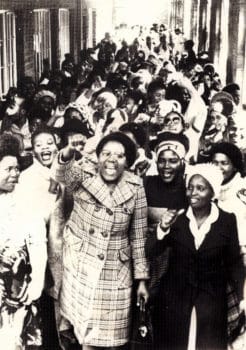
A strike organised by Dano textile workers in Hammarsdale, South Africa, 1982.
Wits Historical Papers
Fanon issues a clear warning about parties aiming to ‘erect a framework around the people that follows an a priori schedule’ and intellectuals deciding to ‘come down into the common paths of real life’ with formulas that are ‘sterile in the extreme’. For Fanon, the vocation of the militant intellectual is to be in the ‘zone of occult instability where the people dwell’, in the ‘seething pot out of which the learning of the future will emerge’, and, there, to ‘collaborate on the physical plane’. He is clear that the university-trained intellectual must avoid both the inability to ‘carry on a two-sided discussion’, to engage in genuine dialogue, and its obverse, becoming ‘a sort of yes man who nods assent at every word coming from the people’. Against this, he recommends ‘the inclusion of the intellectual in the upward surge of the masses’ with a view toward achieving, as noted above, ‘a mutual current of enlightenment and enrichment’.
Fanon affirms the practice of mutuality rooted in an immediate commitment to radical equality, something like Marx’s youthful vision of ‘an association of free human beings who educate one another’. His consistent commitment to the recognition of ‘the open door of every consciousness’ brings him to a radically democratic understanding of struggle rooted in local practices in which dignity is affirmed, discussion carried out, and decisions taken. For Fanon, the primary task of political education is to show that ‘there is no famous man who will take the responsibility for everything, but that the demiurge is the people themselves and the magic hands are finally only the hands of the people’. He affirms the importance of ‘the free exchange of ideas which have been elaborated according to the real needs of the mass of the people’. There are clear resonances with C.L.R. James’ famous assertion that, in a phrase borrowed from Vladimir Lenin, ‘every cook can govern’. Fanon, committed until the end to the emancipation of reason, to its emancipation in and via struggle, ended his last book with the imperative to ‘work out new concepts’.
To be worthy of its name, communist thought must be an expression of intellect in motion, of intellect grounded in real movement, and, therefore, in permanent dialogue with others in struggle. It should carry the militant desire for–in Étienne Balibar’s pithy summation of a central thrust of Benedict Spinoza’s Ethics–‘as many as possible, thinking as much as possible’. This is the form of militancy from which Fanon speaks to us today, with such compelling power, with the brightness of metal.
Further Reading
Cherki, Alice. Frantz Fanon: A portrait. Ithaca, New York: Cornell University Press, 2006.
Elhen, Patrick. Franz Fanon: A spiritual biography. New York: The Crossroad Publishing Company, 2000.
Fanon, Frantz. A Dying Colonialism. New York: Grove Press, 1967.
Fanon, Frantz. Alienation and Freedom. London: Bloomsbury, 2009.
Fanon, Frantz. Black Skin, White Masks. New York: Grove Press, 1967.
Fanon, Frantz. The Wretched of the Earth. London: Penguin, 1976.
Fanon, Frantz. Toward the African Revolution. New York: Grove Press, 1967.
Gibson, Nigel. Fanon: The postcolonial imagination. Londo:. Polity, 2003.
Gibson, Nigel. Fanonian Practices in South Africa: From Steve Biko to Abahlali
baseMjondolo. Pietermaritzburg: University of KwaZulu-Natal Press, 2011.
Gibson, Nigel & Beneduce, Roberto. Frantz Fanon, Psychiatry and Politics.
Johannesburg: University of the Witwatersrand Press, 2017.
Gordon, Lewis. Fanon and the Crisis of European Man: An essay on philosophy and the
human sciences. New York: Routledge, 1995.
Gordon, Lewis. What Fanon Said: A Philosophical Introduction to His Life and Thought.
Johannesburg: University of the Witwatersrand Press, 1996.
Lee, Christopher. Frantz Fanon: Toward a Revolutionary Humanism. Johannesburg: Jacana Press, 2015.
Mbembe, Achille. Necropolitics. Johannesburg: University of the Witwatersrand Press, 2016.
Neocosmos, Michael. Thinking Freedom in Africa: Towards a theory of emancipatory politics.
Johannesburg: University of the Witwatersrand Press, 2016.
Sekyi-Otu, Ato. Fanon’s Dialectic of Experience. Cambridge, MA: Harvard University Press, 1996.
Sekyi-Otu, Ato. Left Universalism, Africacentric Essays. New York: Routledge, 2019.
Sharpley-Whiting, Tracey. Frantz Fanon: Conflicts and Feminisms. Lanham: Roman & Littlefield, 1998.
Wynter, Sylvia. “No Humans Involved: An Open Letter to My Colleagues.” Forum H.H.I. Knowledge for the 21st Century 1.1 (Fall 1994): 42-73.

